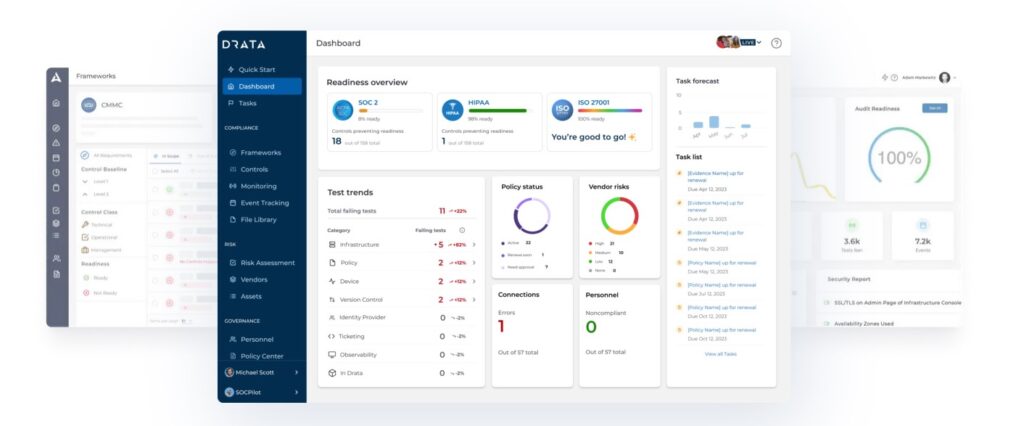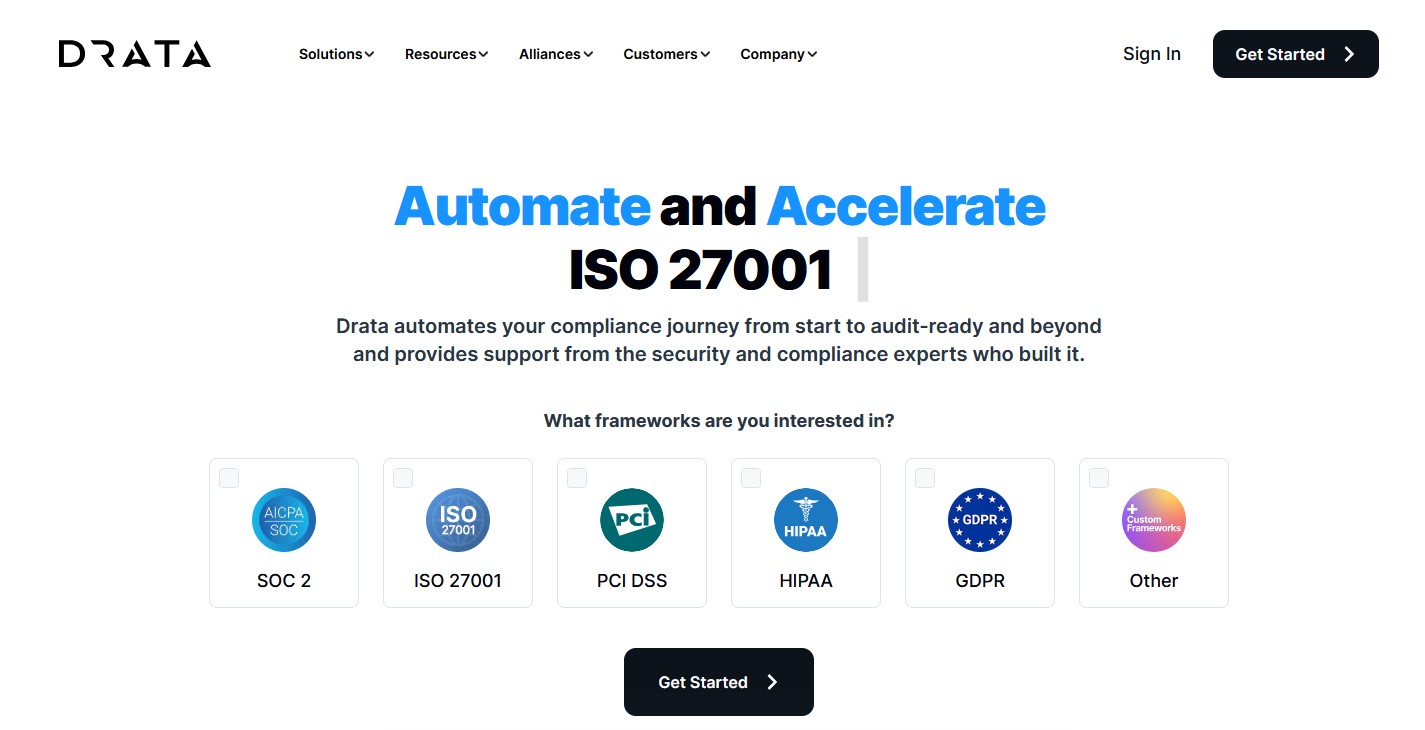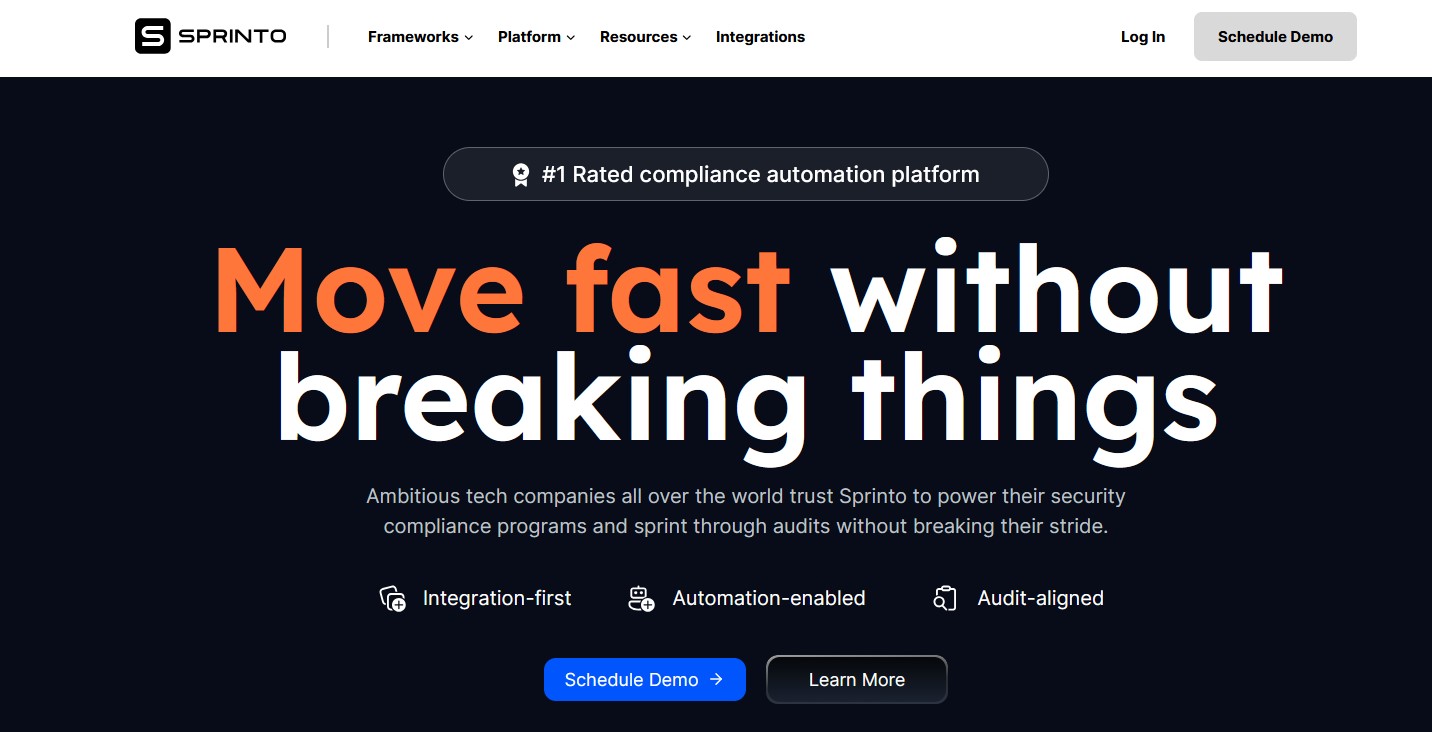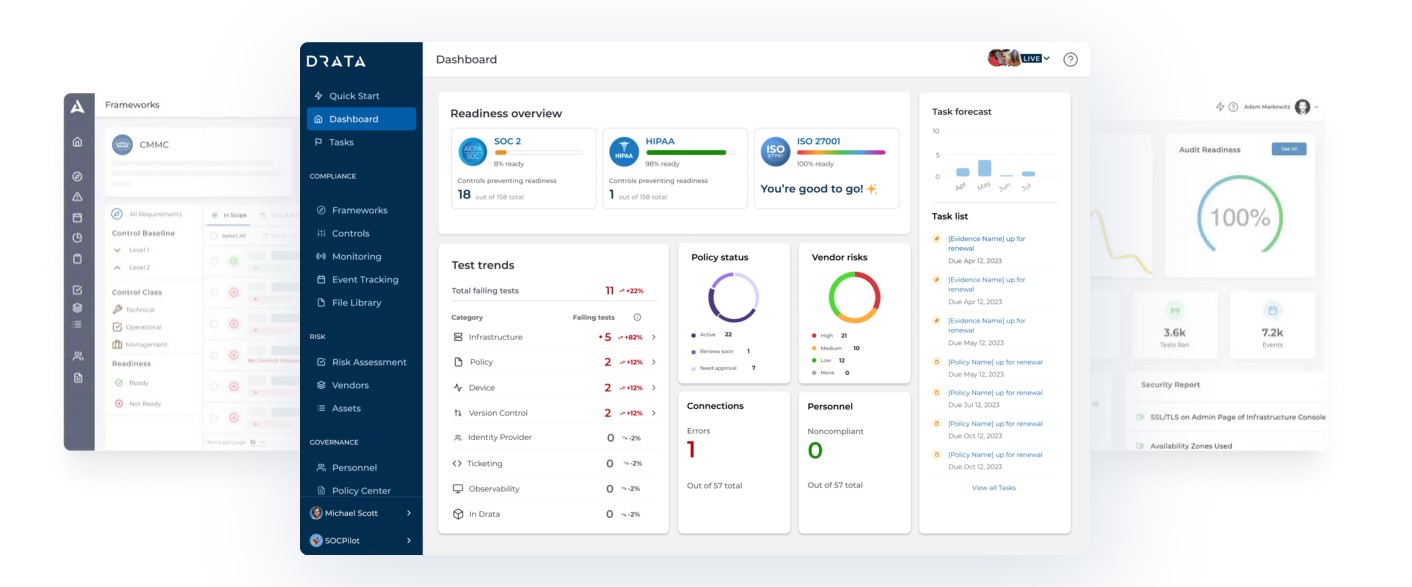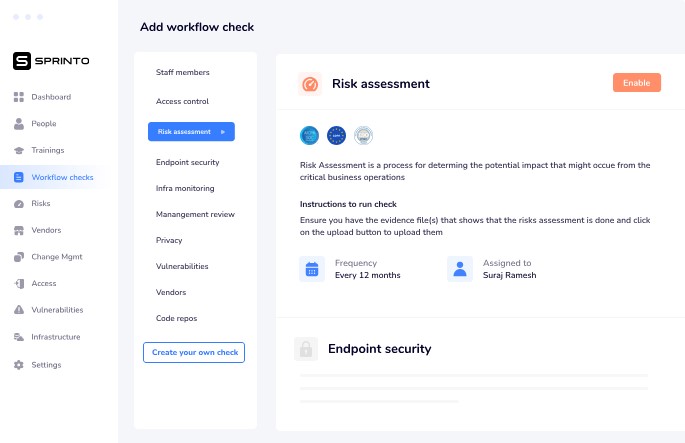Achieving and maintaining compliance with standards such as SOC 2, HIPAA, and GDPR can be a complex and resource-intensive process. Compliance is not just about avoiding fines; it is essential for companies, particularly those in finance, banking, and healthcare-adjacent industries, to protect sensitive data, maintain customer trust, and mitigate risks. This is where compliance management software comes into play. These tools streamline and automate compliance tasks, making it easier for organizations to adhere to regulatory requirements.
With a wide variety of options available, selecting the right tool can be daunting. This article aims to simplify this decision by providing a detailed comparison of two leading compliance management solutions: Drata and Sprinto. By examining their features, pros and cons, pricing, and more, we hope to guide you in choosing the best solution for your organization’s needs.
Overview of Compliance Management Tools
Compliance management tools are essential for businesses navigating the complex web of regulatory requirements. These tools offer automated solutions to monitor, manage, and document compliance efforts, significantly reducing the burden on internal teams. By leveraging these tools, organizations can ensure adherence to standards, gain real-time insights into their compliance status, identify potential risks, and prepare more effectively for audits.
In industries such as healthcare, finance, and technology, where data security and privacy are paramount, the role of compliance management tools becomes even more critical. These tools help mitigate risks associated with data breaches and non-compliance, thereby protecting the organization’s reputation and maintaining customer trust.
The market for compliance management software is large and expanding. Growth in the space is driven by increasing regulatory demands and the need for more efficient compliance processes as regulations change. According to industry reports, the global compliance software market is poised for significant growth in the coming years, propelled by advancements in AI and automation technologies. This trend underscores the importance of choosing a tool that not only meets current needs but also adapts to future regulatory changes and technological advancements.
Drata and Sprinto: Key Players in the Market
Drata and Sprinto have emerged as prominent players in the compliance management software market, each offering comprehensive solutions designed to simplify compliance processes. However, they cater to different business needs and preferences through distinct approaches.
By comparing Drata and Sprinto across various dimensions—such as key features, user experience, pricing, and support— this article aims to provide a clear and thorough understanding of what each tool offers. Whether you are a startup looking to establish compliance foundations or an enterprise seeking to enhance existing processes, this comparison will help you determine which solution aligns best with your specific needs.
Overview
Here is a quick overview of Drata and Sprinto.
Drata
One of the two largest players in the compliance management software space, Drata is renowned for its robust feature set and user-friendly interface. It focuses on automating compliance monitoring and providing customizable templates to ease the documentation process. Drata integrates seamlessly with over 120 tools, making it a versatile option for businesses looking to streamline their compliance efforts. Its emphasis on efficiency and accessibility makes it a popular choice for medium to large enterprises.
Sprinto
Sprinto stands out among competitors with its extensive integrations and advanced automation capabilities. It integrates with over 160 tools — which is a lot for this industry, even compared to larger players like Drata. Sprinto leverages AI to provide real-time compliance insights and streamline processes, making it particularly well-suited for SaaS companies and tech firms. Its comprehensive support for multiple frameworks, including SOC 2, ISO 27001, and HIPAA, ensures that businesses can manage a wide range of compliance requirements.
Understanding the Role of Drata and Sprinto
Here are some more details about Drata and Sprinto in the compliance industry.
Drata
Drata helps organizations stay compliant with various standards, including SOC 2, HIPAA, and GDPR. It offers automated monitoring, customizable templates, and efficient onboarding, making compliance less daunting.
Sprinto
Sprinto also supports multiple frameworks like SOC 2, ISO 27001, and HIPAA, with a strong emphasis on integrations and AI-driven automation. Its platform integrates with over 160 tools, providing a centralized hub for compliance management.
Key Functions and Benefits
Drata
- Automated compliance monitoring
- Customizable policy templates
- Fast implementation
- 24/7 customer support
- Integration with over 120 tools
- Customizable trust center
- Centralized document management
Sprinto:
- Advanced automation
- Over 160 integrations
- Real-time compliance insights
- Personalized support from compliance experts
- Efficient onboarding process
- Comprehensive support for multiple frameworks
- Intuitive user interface
Purpose of Comparison
This comparison aims to provide an in-depth analysis of Drata and Sprinto, focusing on key features, pros and cons, target audiences, and other critical factors. Our goal is to help you make an informed decision based on your specific needs and preferences.
Comparing Drata to Sprinto
Here are some of the key features from both platforms.
Drata
- Comprehensive Compliance Monitoring: Ensures continuous audit readiness and proactive risk management.
- Pre-Canned Policies and Templates: Reduces documentation costs with customizable, audit-ready templates.
- Structured Onboarding and Support: Fast implementation with 24/7 customer support.
- Integration and Scalability: Integrates with over 120 tools, allowing for organizational growth.
- Customizable Trust Center: Tailored compliance solutions to meet specific needs.
- Centralized Document Management: Improves accessibility for auditors and employees.
Sprinto
- Compliance Management: Streamlines tracking and management of regulatory compliance.
- Risk Management: Facilitates risk identification, analysis, and mitigation.
- Audit Trail: Maintains detailed logs for accountability and direct auditor interaction.
- Document Management: Organizes and securely stores compliance-related documents.
- Policy Management: Central dashboard for policy development, distribution, and monitoring.
- Advanced Automation: AI-driven processes optimize compliance tasks.
Pros and Cons
Here are some of the pros and cons for each platform.
Drata
Pros:
- Efficient implementation and configuration
- Cost-effective, customizable templates
- Integrated approach reducing operational time
- Supports multiple compliance frameworks
- Enhanced accessibility and compliance tracking
Cons:
- No pre-built HITRUST framework
- Fewer third-party integrations compared to competitors
- Need for more visibility on recurring tasks
- Complexity can overwhelm new users
- Policy editor could be more intuitive
- Free trust center lacks configurability
Sprinto
Pros:
- Personalized support from compliance experts
- Efficient onboarding process
- Accelerated compliance timelines
- Clear insights into organizational vulnerabilities
- Seamless integration with over 160 systems
- Intuitive user interface
Cons:
- Limited integration with GitLab
- Occasional minor bugs and sync glitches
- Issues with audio quality on conference calls
- Documentation edits needed for multiple entities
Target Audience
Here are the main target audiences for each platform.
Drata
Drata is ideal for medium and large startups, large enterprises, and auditors aiming to meet compliance standards like SOC 2. It caters to organizations seeking to automate compliance processes, especially in technology, finance, and healthcare sectors.
Sprinto
Sprinto targets businesses looking to streamline compliance processes, particularly those adhering to SOC 2 and ISO 27001 standards. It is well-suited for SaaS companies, tech firms, and enterprises that require efficient compliance and audit procedures.
In-depth Reviews of Drata and Sprinto
Here are some more detailed reviews of Drata and Sprinto.
Drata
Drata is a comprehensive compliance management tool designed to help organizations meet various regulatory standards such as HIPAA and SOC 2. Its user-friendly interface and efficient setup process make it popular among businesses of all sizes.
Key Features
Drata offers automated compliance monitoring, customizable policy templates, and structured onboarding. Its integration with over 120 tools and centralized document management system enhance its functionality and ease of use.
User Experience
Drata provides a user-friendly interface with a clear dashboard that simplifies compliance tracking. Users appreciate the structured onboarding process and responsive customer support, which ensure a smooth setup and ongoing assistance.
Pricing and Value
Drata’s pricing ranges from $20,000 to $100,000, depending on company size and the chosen compliance framework. This pricing reflects its comprehensive features and extensive customer support, making it a valuable investment for businesses prioritizing efficiency and compliance.
Customer Support
Drata offers 24/7 customer support, ensuring that users can get assistance whenever needed. The support team is known for being responsive and helpful, aiding in smooth implementation and addressing any issues promptly.
Integration and Scalability
With integration capabilities for over 120 tools, Drata provides significant flexibility and scalability. It can grow with your organization, adapting to increasing compliance needs and integrating with various systems.
Vendor Reputation
Drata is well-regarded in the industry for its robust features and customer-centric approach. It has a strong track record of helping businesses achieve and maintain compliance across multiple frameworks.
Sprinto
Sprinto is a leading compliance platform that integrates with clients’ HR, IT, and engineering systems through over 160 connections. It supports a wide range of frameworks, including SOC 2, ISO 27001, GDPR, and HIPAA.
Key Features
Sprinto excels with its advanced automation and AI-driven processes. It offers real-time compliance insights, seamless integrations, and comprehensive support for multiple frameworks, making it a robust choice for businesses.
User Experience
Sprinto provides an intuitive user interface and personalized support from compliance experts. Users benefit from efficient onboarding and clear insights into their compliance status, making the process straightforward and effective.
Pricing and Value
Sprinto does not publicly list its pricing but offers a pricing calculator on its website. This flexibility allows organizations to tailor their investment according to specific needs and scales.
Customer Support
Sprinto offers personalized support from compliance experts, ensuring that clients have the resources needed to succeed in their compliance endeavors. The support team is known for its proactive approach and helpful guidance.
Integration and Scalability
Sprinto’s integration with over 160 systems provides a centralized compliance hub, enhancing accuracy and transparency. Its scalability options ensure that it can accommodate growing compliance needs.
Vendor Reputation
Sprinto is respected in the industry for its innovative approach to compliance management. Its use of AI and extensive integration capabilities have earned it a strong reputation among businesses.
Methodology
The analysis of Drata and Sprinto was conducted based on several criteria: regulatory compliance capabilities, risk management, data security, ease of use, integration, vendor support, pricing, and overall value. These factors were chosen to provide a comprehensive evaluation of each software’s strengths and weaknesses, ensuring a balanced and informative comparison.
- Regulatory Compliance: How well the software supports various compliance standards.
- Risk Management: The ability to identify, analyze, and mitigate risks.
- Data Security: Measures in place to protect sensitive information.
- Ease of Use: User interface, setup process, and overall usability.
- Integration: Compatibility with other systems and tools.
- Vendor Support: Availability and quality of customer support services.
- Pricing: Cost structure and overall value for the features provided.
Conclusion
Drata and Sprinto are both robust compliance management tools with unique strengths. Drata excels in policy and risk management with a focus on comprehensive features and integrations. Sprinto stands out for its advanced automation and extensive support, particularly for cloud-hosted SaaS companies. Your choice between the two will depend on your specific needs, such as the depth of integrations, ease of use, or the level of automation and support required.
Final Thoughts
Choosing the right compliance management tool is crucial for maintaining regulatory compliance and protecting your business. Both Drata and Sprinto offer powerful solutions, but it’s important to consider your unique requirements and preferences. We encourage you to explore further, conduct your own research, and consult with compliance experts to make the best decision for your organization.
